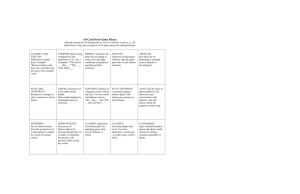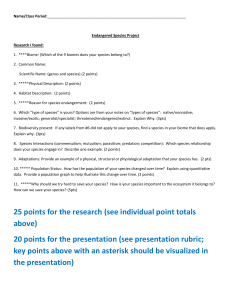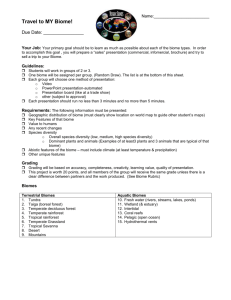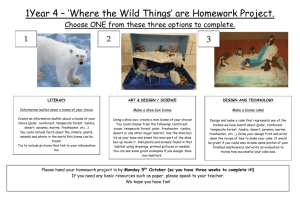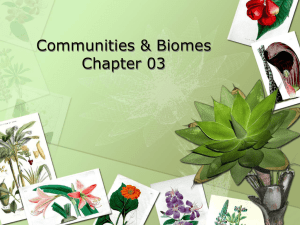File - Ms. Frye`s 7th grade Accelerated Science
advertisement
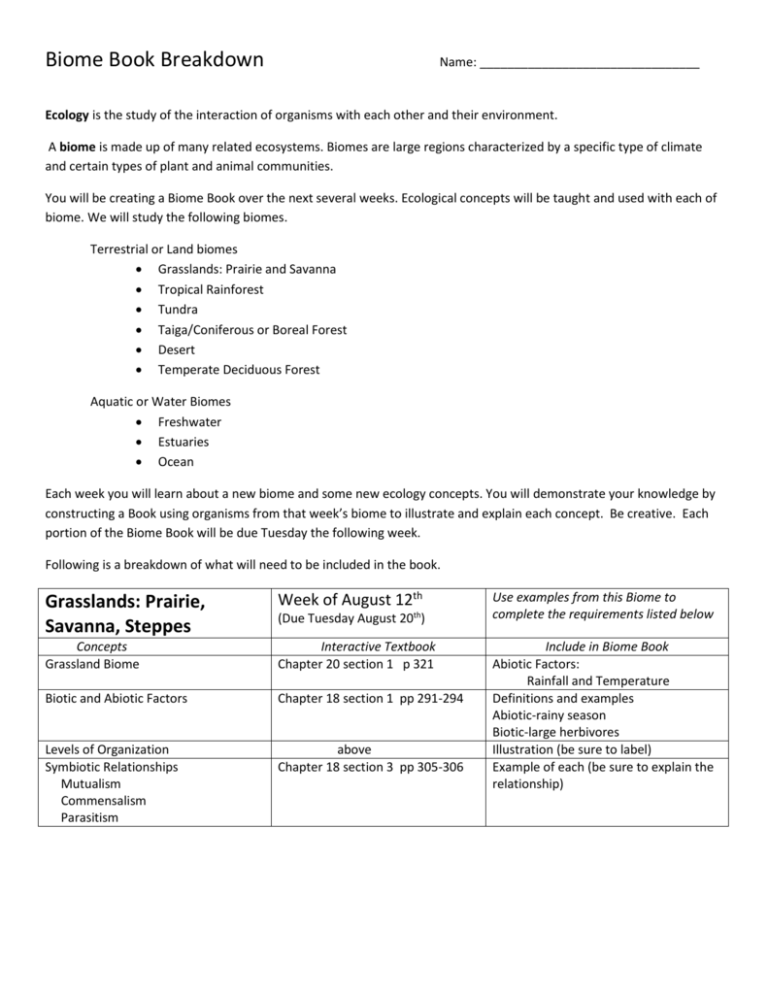
Biome Book Breakdown Name: ________________________________ Ecology is the study of the interaction of organisms with each other and their environment. A biome is made up of many related ecosystems. Biomes are large regions characterized by a specific type of climate and certain types of plant and animal communities. You will be creating a Biome Book over the next several weeks. Ecological concepts will be taught and used with each of biome. We will study the following biomes. Terrestrial or Land biomes Grasslands: Prairie and Savanna Tropical Rainforest Tundra Taiga/Coniferous or Boreal Forest Desert Temperate Deciduous Forest Aquatic or Water Biomes Freshwater Estuaries Ocean Each week you will learn about a new biome and some new ecology concepts. You will demonstrate your knowledge by constructing a Book using organisms from that week’s biome to illustrate and explain each concept. Be creative. Each portion of the Biome Book will be due Tuesday the following week. Following is a breakdown of what will need to be included in the book. Grasslands: Prairie, Savanna, Steppes Week of August 12th Concepts Grassland Biome Interactive Textbook Chapter 20 section 1 p 321 Biotic and Abiotic Factors Chapter 18 section 1 pp 291-294 Levels of Organization Symbiotic Relationships Mutualism Commensalism Parasitism above Chapter 18 section 3 pp 305-306 (Due Tuesday August 20th) Use examples from this Biome to complete the requirements listed below Include in Biome Book Abiotic Factors: Rainfall and Temperature Definitions and examples Abiotic-rainy season Biotic-large herbivores Illustration (be sure to label) Example of each (be sure to explain the relationship) Biome Book Breakdown Name: ________________________________ Aquatic: Freshwater, Estuary, and Marine Week of August 19th Concepts Freshwater Lakes and Ponds Rivers and Streams Wetlands: marsh, swamp, bog Marine Estuary Food Chains Producer Consumer Herbivore Carnivore Omnivore Decomposer Interactive Textbook Chapter 20 section 3 pp 331-334 Include in Biome Book Create a freshwater food chain. Label producer, consumer, decomposer Chapter 20 section 2 pp 328-330 Create a marine food web with at least 3 producers and 5-7 consumers) Create a chart like the one below using organisms found in an Estuary Biotic Factors Chart for an Estuary Producers (define) Give 3 examples Consumer (define) *Herbivore (define) -give 3 examples * Carnivore (define) - give 3 examples * Omnivore (define) -give 3 examples Tundra Week of August 26th (Taiga due same day) (Due Tuesday September 3 ) Concepts Tundra: Polar and Alpine Interactive Textbook Chapter 20 section 1 p 323 Permafrost Autotroph Heterotroph Predation Predator Prey Chapter 20 section 1 p 323 Food Web Chapter 18 section 2 pp 297-298 Use examples from this Biome to complete the requirements listed below (Due Tuesday August 27th) Chapter 18 section 2 pp 295-297 rd Chapter 18 section 3 pp 303-304 Use examples from this Biome to complete the requirements listed below Include in Biome Book Abiotic Factors: Rainfall and Temperature Write definition Include a chart like the one below using organism found in a Tundra Biotic Factors Chart for the Tundra Autotroph: (define) Give 2 examples and describe the adaptations that help it survive in the Tundra Heterotrophs: Predator: Give 2 examples and describe the adaptations that help it survive in the Tundra Prey: Give 2 examples and describe the adaptations that help it survive in the Tundra Create a food web using 3 producers and 5-7 consumers Biome Book Breakdown Taiga: also called Boreal or Coniferous Forest Concepts Name: ________________________________ Week of August 26th rd (Due Tuesday September 3 ) Taiga Interactive Textbook Chapter 20 section 1 p 319 Adaptations Chapter 18 section 3 pp 304-305 Autotroph Heterotroph Predator/Prey Chapter 18 section 3 pp 303-304 Food Chain Primary consumer Secondary consumer Tertiary consumer Chapter 18 section 2 pp 296-297 Energy Pyramid Chapter 18 section 2 pp 298-299 Compare/Contrast a Taiga with the Tundra Use examples from this Biome to complete the requirements listed below Include in Biome Book Abiotic Factors: Rainfall and Temperature Include a chart like the one below Biotic Factors Chart for the Tundra Autotroph: (define) Give 2 examples, describe the adaptations that help it survive Heterotrophs: Predator: Give 2 examples, describe the adaptations that help it survive in the Taiga Prey: Give 2 examples, describe the adaptations that help it survive in the Taiga Create a food chain: Label: producer 1st level consumer 2nd level consumer 3rd level consumer Use the food chain to create an energy pyramid Write a comparison of a Taiga and the Tundra Biome Book Breakdown Tropical Rainforest Name: ________________________________ Week of September 3rd Concepts Tropical Rainforest (Due Tuesday September 10th) Interactive Textbook Chapter 20 section 1 p 320 Competition Chapter 18 section 3 p 303 Symbiosis Mutualism Commensalism Parasitism Biotic and Abiotic Factors Chapter 18 section 3 pp 305-306 Chapter 20 section 1 p 317 Use examples from this Biome to complete the requirements listed below Include in Biome Book Abiotic Factors: Rainfall and Temperature Give an example of competition with plants and another between animals Give two examples of each symbiotic relationships found in a tropical rainforest Include a chart like the one below using organism found in a Tropical Rainforest Biotic Factors Chart for a Rainforest Producers (define) Give 3 examples Consumer (define) *Herbivore (define) -give 3 examples * Carnivore (define) - give 3 examples * Omnivore (define) -give 3 examples Biome Book Breakdown Name: ________________________________ Week of September 10th Desert (Due Tuesday September 17th) Concepts Desert Interactive Textbook Chapter 20 section 1 p 322 Use examples from this Biome to complete the requirements listed below Include in Biome Book Abiotic Factors: Rainfall and Temperature Give an example of two of the three symbiotic relationships Symbiosis Mutualism Commensalism Parasitism Biotic Factors Chapter 18 section 3 pp 305-306 Competition Predation Chapter 18 section 3 p 303 Chapter 18 section 3 pp 303-304 Give 2 examples Give 2 examples of predator/prey relationships. Identify which is the predator and which is the prey Temperate Deciduous Forest Week of September 16th Concepts Temperate Deciduous Forest Interactive Textbook Chapter 20 section 1 p 318 Levels of Organization Chapter 18 section 1 pp 292-293 Food Web Food Chain Chapter 18 section 2 pp 297-298 Chapter 18 section 2 pp 296-297 Energy Pyramid Chapter 18 section 2 pp 298-299 Use examples from this Biome to complete the requirements listed below Include in Biome Book Abiotic Factors: Rainfall and Temperature Illustrate the levels of organization in a deciduous forest biome Create a food web Select one food chain from the web. Draw and label herbivores, carnivores and herbivores Use the food chain to make an energy pyramid Biotic Factors Chart for a Desert Producers -give 1 example Heterotroph *Herbivore (define) -give 2 examples, describe the adaptations that help it survive in the desert * Carnivore (define) -give 2 examples, describe the adaptations that help it survive in the desert * Omnivore (define) -give 2 examples, describe the adaptations that help it survive in the desert (Due Tuesday September 24th) Biome Book Breakdown Name: ________________________________ Dear Parents and Students, Please look over the requirements of the Biome Book Project and sign the agreement below. Return the signed page by Monday, August 12, 2013. You may keep the rest of the papers as a reference. The entire packet will be uploaded on to the Fryerms.weebly.com website for your convenience. The Biome Book weekly grades will constitute the classwork grades on the report card. That means for the first quarter of the grading period, 40% will be based on this project. The students will take three common assessments during the course of the first seven weeks. These tests will constitute 45% of the grade. Please be aware that this, and the science fair are the only major projects I require for the year. Other than these two projects, I require little to no homework from my students. The science fair project will not be due until Thanksgiving. More information will come at a later time, but I do recommend that you begin thinking about a topic. Sincerely, Ms. Betsy Frye Agreement: Please sign and return to Ms. Frye I have seen the requirements and timeline for the Biome Book Project. I am aware that a section of the book is due every week, and that some time in class will be allotted to work on the book, but that the majority of class time will be designated to learning new concepts. Therefore, the bulk of the book will need to be completed at home. I am aware of the deadlines and will adhere to said deadlines. I am aware that Ms. Frye expects the work to be completed and turned in on time. I am also aware that a zero will be given for portions not turned in. ___________________________________________ ________________________________________ Print Student’s name Student’s Signature ___________________________________________ ________________________________________ Print Parent’s name Parent’s Signature Date _______________________________________

